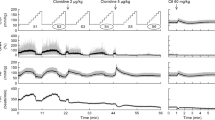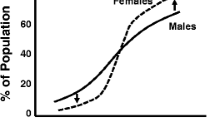Abstract
Purpose: Clonidine is a classical sympatholytic drug that is widely used for the treatment of hypertension. Experimental and clinical studies suggest that Clonidine may activate baroreflex. The aim of this study was to determine the hemodynamic response to Clonidine under physiological conditions and to test the hypothesis that Clonidine would reduce cardiac output and blood pressure resulting in an increase in total peripheral resistance.
Methods: Clonidine’s hemodynamic effect was evaluated in 28 young, healthy subjects after a single i.v. dose of 1 μ g × kg− 1. Impedance cardiography, systolic time intervals and pulse wave analysis were used to characterize myocardial and vascular function.
Results: Clonidine lowered blood pressure, heart rate, left ventricular ejection time, and pulse wave velocity and increased pre-ejection period. Stroke volume and cardiac output decreased gradually over the investigation time of 240 min. Central systolic blood pressure (SBP) was lowered to a larger extent than peripheral SBP. Total peripheral resistance was characterized by an immediate fall of short duration followed by a continuous rise above baseline after 120 min. Placebo did not have any significant effect on hemodynamic parameters.
Conclusions: Clonidine’s blood pressure lowering effect is mediated by both an immediate decrease in vascular resistance and a prolonged decrease in cardiac output, and Clonidine lowers central SBP more than peripheral SBP.
Similar content being viewed by others
References
Bylund DB, Bond RA, Clarke DE, et al. Adrenoceptors. In: The IUPHAR Receptor Compendium of Receptor Characterization and Classification. London: IUPHAR Media, 1998:58–74.
Johnson A, Blackwell CP, Smith J. Antagonism of the effects of clonidine by the alpha2-adrenoceptor antagonist, fluparoxan. J Clin Pharmac 1995;39:477–483.
Aicher SA, Drake CT. Clonidine evokes vasodepressor responses via alpha2-adrenergic receptors in gigantocellular reticular formation. J Pharmacol Exp Ther 1999;289(2):688–694.
Epstein M. Diagnosis and management of hypertensive emergencies. Clin Cornerstone 1999;2(1):41–54.
Grossman E, Ironi AN, Messerli FH. Comparative tolerability profile of hypertensive crisis treatments. Drug Saf 1998;19(2):99–122.
Rahn KH. How should we treat a hypertensive emergency? Am J Cardiol 1989;63(6):48C–50C.
Kimber J, Sivenandan M, Watson L, Mathias CJ. Age- and gender-related growth hormone responses to intravenous clonidine in healthy adults. Growth Horm IGF Res 2001;11(2):128–135.
Bamberger CM, Monig H, Mill G, Godde E, Schulte HM. Growth hormone secretion in response to the new centrally acting antihypertensive agent moxonidine in normal human subjects: Comparison to clonidine and GHRH. Exp Clin Endocrinol Diabetes 1995;103(3):205–208.
Lenz T, Gossmann J, Schulte KL, Salewski L, Geiger H. Diagnosis of pheochromocytoma. Clin Lab 2002;48(1/2):5–18.
Figueroa XF, Poblete MI, Boric MP, Mendizabal VE, Adler-Graschinsky E, Huidobro-Toro JP. Clonidine-induced nitric oxide-dependent vasorelaxation mediated by endothelial alpha(2)-adrenoceptor activation. Br J Pharmacol 2001;134(5):957–968.
Kamata K, Kanie N, Inose A. Mechanisms underlying attenuated contractile response of aortic rings to noradrenaline in fructose-fed mice. Eur J Pharmacol 2001;428(2):241–249.
Atalik KE, Sahin AS, Dogan N. Interactions between phenylephrine, clonidine and xylazine in rat and rabbit aortas. Methods Find Exp Clin Pharmacol 2000;22(3):145–147.
Sunano S, Li-Bo Z, Matsuda K, Sekiguchi F, Watanabe H, Shimamura K. Endothelium-dependent relaxation by alpha 2-adrenoceptor agonists in spontaneously hypertensive rat aorta. J Cardiovasc Pharmacol 1996;27(5):733–739.
van Zwieten PA. Renewed interest in centrally acting antihypertensive drugs. Cardiovasc J S Afr 2000;11(4):225–229.
Prichard BN, Graham BR. The use of moxonidine in the treatment of hypertension. J Hypertens Suppl 1997;15(1):S47–S55.
Kooner JS, Birch R, Frankel HL, Peart WS, Mathias CJ. Hemodynamic and neurohormonal effects of clonidine in patients with preganglionic and postganglionic sympathetic lesions. Evidence for a central sympatholytic action. Circulation 1991;84(1):75–83.
Kallio A, Saraste M, Scheinin M, Hartiala J, Scheinin H. Acute hemodynamic effects of medetomidine and clonidine in healthy volunteers: A noninvasive echocardiographic study. J Cardiovasc Pharmacol 1990;16(1):28–33.
Dabire H, Richer C. Implication of the central nervous system in the systemic and regional hemodynamics of two centrally acting hypotensive drugs, flesinoxan and clonidine, in the rat. J Cardiovasc Pharmacol 1991;18(4):605–613.
El-Mas MM, Abdel-Rahman AA. Role of cardiac output in ethanol-evoked attenuation of centrally mediated hypotension in conscious rats. Hypertension 1997;30(2 Pt 1):288–294.
Parlow J, Viale JP, Annat G, Hughson R, Quintin L. Spontaneous cardiac baroreflex in humans. Comparison with drug-induced responses. Hypertension 1995;25(5):1058–1068.
el-Mas MM, Carroll RG, Abdel-Rahman AA. Centrally mediated reduction in cardiac output elicits the enhanced hypotensive effect of clonidine in conscious aortic barodenervated rats. J Cardiovasc Pharmacol 1994;24(2):184–193.
Taira CA. Anticholinergic action of clonidine in rats with sinoaortic denervation. Pharmacol Res 1998;37(4):255–263.
Korner PI, Oliver JR, Sleight P, Robinson JS, Chalmers JP. Assessment of cardiac autonomic excitability in renal hypertensive rabbits using clonidine-induced resetting of the baroreceptor-heart rate reflex. Eur J Pharmacol 1975;33(2):353–362.
Parlow JL, Begou G, Sagnard P, et al. Cardiac baroreflex during the postoperative period in patients with hypertension: Effect of clonidine. Anesthesiology 1999;90(3):681–692.
Kubicek WG, Karnegis JN, Patterson RP, Witsoe DA, Mattson RH. Development and evaluation of an impedance cardiac output system. Aerosp Med 1966;37(12):1208–1212.
Kubicek WG, From AH, Patterson RP, et al. Impedance cardiography as a noninvasive means to monitor cardiac function. J Assoc Adv Med Instrum 1970;4(2):79–84.
Northridge DB, Findlay IN, Wilson J, Henderson E, Dargie HJ. Non-invasive determination of cardiac output by doppler echocardiography and electrical bioimpedance. Br Heart J 1990;63:93–97.
White SW, Quail AW, de Leeuw PW, et al. Impedance cardiography for cardiac output measurement: An evaluation of accuracy and limitations. Eur Heart J 1990;11(Suppl I):79–92.
Schafers RF, Nurnberger J, Herrmann B, Wenzel RR, Philipp T, Michel MC. Adrenoceptors mediating the cardiovascular and metabolic effects of alpha-methylnoradrenaline in humans. J Pharm Exp Ther 1999;289(2):918–925.
Lewis RP, Rittgers SE, Forester WF, Boudoulas H. A critical review of the systolic time intervals. Circulation 1977;56(2):146–158.
Li Q, Belz GG. Systolic time intervals in clinical pharmacology. Eur J Clin Pharmacol 1993;44(5):415–421.
Nurnberger J, Opazo Saez A, Dammer S, et al. Left ventricular ejection time: A potential determinant of pulse wave velocity in young, healthy males. J Hypertens 2003;21(11):2125–2132.
Boudoulas H. Systolic time intervals. Eur Heart J 1990;11(Suppl. I):93–104.
Nurnberger J, Dammer S, Opazo Saez A, Philipp T, Schafers RF. Diastolic blood pressure is an important determinant of augmentation index and pulse wave velocity in young, healthy males. J Hum Hypertens 2003;17(3):153–158.
Breithaupt-Grögler K, Ling M, Boudoulas H, Belz GG. Protective effect of chronic garlic intake on elastic properties of aorta in the elderly. Circulation 1997;96:2649–2655.
Breithaupt K, Erb KA, Neumann B, Wolf GK, Belz GG. Comparison of four noninvasive techniques to measure stroke volume: Dual-beam doppler echoaortography, electrical impedance cardiography, mechanosphygmography and mode echocardiography of the left ventricle. Am J Noninvas Cardiol 1990;4:203–209.
Kelly R, Hayward C, Avolio A, O’Rourke M. Noninvasive determination of age-related changes in the human arterial pulse. Circulation 1989;80(6):1652–1659.
O’Rourke MF, Gallagher DE. Pulse wave analysis. J Hypertens Suppl 1996;14(5):147–157.
Wilkinson IB, Cockcroft JR, Webb DJ. Pulse wave analysis and arterial stiffness. J Cardiovasc Pharmacol 1998;32(Suppl 3):S33–S37.
Karamanoglu M, O’Rourke MF, Avolio AP, Kelly RP. An analysis of the relationship between central aortic and peripheral upper limb pressure waves in man. Eur Heart J 1993;14(2):160–167.
Nichols WW, O’Rourke MF. McDonald’s Blood Flow in Arteries. Theoretical, Experimental and Clinical Principles, 4th edition. London: Edward Arnold, 1998.
Roland EQ, Safar ME, Lelguen CE, Aboras NE, Weiss YA, Milliez PM. Effect of certain antiadrenergic agents on systolic time intervals in essential hypertension. Eur J Clin Pharmacol 1977;11(6):423–427.
Grassi G, Turri C, Seravalle G, Bertinieri G, Pierini A, Mancia G. Effects of chronic clonidine administration on sympathetic nerve traffic and baroreflex function in heart failure. Hypertension 2001;38(2):286– 291.
El-Mas MM, Abdel-Rahman AA. Role of the sympathetic control of vascular resistance in ethanol-clonidine hemodynamic interaction in SHRs. J Cardiovasc Pharmacol 1999;34(4):589–596.
Estato V, Araujo CV, Bousquet P, Tibirica E. Effects of centrally acting antihypertensive drugs on the microcirculation of spontaneously hypertensive rats. Braz J Med Biol Res 2004;37(10):1541–1549.
Ferrari AU, Radaelli A, Centola M. Invited review: Aging and the cardiovascular system. J Appl Physiol 2003;95(6):2591–2597.
Mukkamala R, Toska K, Cohen RJ. Noninvasive identification of the total peripheral resistance baroreflex. Am J Physiol Heart Circ Physiol 2003;284(3):H947–H959.
Kelly RP, Gibbs HH, O’Rourke MF, et al. Nitroglycerin has more favourable effects on left ventricular afterload than apparent from measurement of pressure in a peripheral artery. Eur Heart J 1990;11(2):138–144.
Author information
Authors and Affiliations
Corresponding author
Additional information
This study was supported in part by the Oertel foundation.
Rights and permissions
About this article
Cite this article
Mitchell, A., Bührmann, S., Saez, A.O. et al. Clonidine Lowers Blood Pressure by Reducing Vascular Resistance and Cardiac Output in Young, Healthy Males. Cardiovasc Drugs Ther 19, 49–55 (2005). https://doi.org/10.1007/s10557-005-6890-6
Issue Date:
DOI: https://doi.org/10.1007/s10557-005-6890-6




